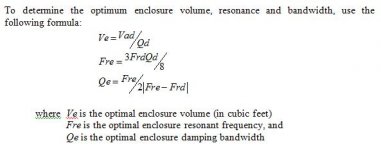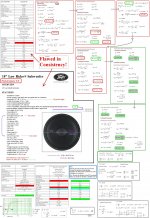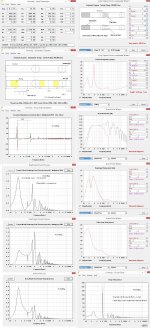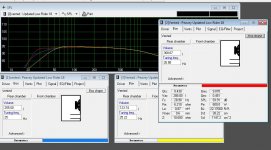I’m looking at this driver:http://assets.peavey.com/literature/specs/117174_13678.pdf
Peavey has (in the above link) 4 different sized “recommended vented enclosures” for this driver from small to large. I’m not sure which one will be best for me.
I don’t mind having a really large box, 255 liters is okay with me. For my goal, it’s more important for the bass to be tight. Getting <25Hz is not the highest priority for me. I only need to cover the range from ~35Hz up to about 100Hz or so.
My question is, why does
Peavey recommend 255 liters, with Vb 30Hz,
But
WinISD suggests a C4/SC4-(Sub) Chebychev of 368.67 liters and a tuning of 26.88Hz ??
I want to choose this driver because I’m really hoping to be able to use amplifiers that I built. They’re not high power by any means. I have not found many options >94 dB 1m/1w that have any kind of Xmax or Fs for bass region.
Can anyone suggest which box would sound better, and why? Sorry, I know “better” is a difficult term to use, but I did try to outline my goals above. Maybe this will help: I listen to mostly Rock and often Jazz. If you’ve never heard Tony Overwater (Cello Solo Artist), he has this track on youtube now.
Thanks,
AlexQS
Peavey has (in the above link) 4 different sized “recommended vented enclosures” for this driver from small to large. I’m not sure which one will be best for me.
I don’t mind having a really large box, 255 liters is okay with me. For my goal, it’s more important for the bass to be tight. Getting <25Hz is not the highest priority for me. I only need to cover the range from ~35Hz up to about 100Hz or so.
My question is, why does
Peavey recommend 255 liters, with Vb 30Hz,
But
WinISD suggests a C4/SC4-(Sub) Chebychev of 368.67 liters and a tuning of 26.88Hz ??
I want to choose this driver because I’m really hoping to be able to use amplifiers that I built. They’re not high power by any means. I have not found many options >94 dB 1m/1w that have any kind of Xmax or Fs for bass region.
Can anyone suggest which box would sound better, and why? Sorry, I know “better” is a difficult term to use, but I did try to outline my goals above. Maybe this will help: I listen to mostly Rock and often Jazz. If you’ve never heard Tony Overwater (Cello Solo Artist), he has this track on youtube now.
Thanks,
AlexQS
Peavy's alignments are all prosound oriented whereas WinISD's default [if there is one] is probably the designer's choice since historically a T/S max flat BW [4th order Butterworth] is the standard.
Regardless, with a > ~ 0.4 Qts [from dim memory it's a bit higher in reality], the normal default tuning would be a little > Vas tuned a little < Fs, so for a 'tight' bass alignment will require either damping the box/vent and or tuning it lower to somewhat < the C4/SC4 alignment.
If you want a really 'tight' response, then a PiAlign or well damped TL is the way to go short of a large compression horn.
For max efficiency short of a large compression horn, then the T/S max flat alignment is your best bet, which will be around 353 L/27 Hz Fb using the published specs and if your amp is a high output impedance one, then ideally you'll need to factor in this added resistance to calculate its higher effective Qts, which will necessitate an even larger cab, though best tuned to the driver's actual Fs, which unfortunately often has the side effect of making the bass sound a bit 'boomy'/'loose', so critically damping the vent is required in these cases.
GM
Regardless, with a > ~ 0.4 Qts [from dim memory it's a bit higher in reality], the normal default tuning would be a little > Vas tuned a little < Fs, so for a 'tight' bass alignment will require either damping the box/vent and or tuning it lower to somewhat < the C4/SC4 alignment.
If you want a really 'tight' response, then a PiAlign or well damped TL is the way to go short of a large compression horn.
For max efficiency short of a large compression horn, then the T/S max flat alignment is your best bet, which will be around 353 L/27 Hz Fb using the published specs and if your amp is a high output impedance one, then ideally you'll need to factor in this added resistance to calculate its higher effective Qts, which will necessitate an even larger cab, though best tuned to the driver's actual Fs, which unfortunately often has the side effect of making the bass sound a bit 'boomy'/'loose', so critically damping the vent is required in these cases.
GM
I have another question
Thanks GM. I’ve come across several of your posts in all of my reading in the last month. You are very helpful! J
Let me make sure I understand:
And Fs is 28.9 in this case. That’s why the Vb box tuning they recommend is 30Hz
__
Regarding the Pi Alignment. I read his paper, and started to work out his formula for optimum cabinet size. Note I looked up that Qd = 1/Qm + 1/Qe, and also that Fts and Frd are the same thing, and Vas and Vad the same too. Please help me to see my error if I’ve gotten misinformation there.
I was a little surprised with my solutions though. I came up with Ve (optimum enclosure volume in cubic feet) is only 4.36, that’s only 123.4 liters.
I used Excel, and typed it basically like this:
To get Ve I entered =sum(Vas/Qd) the result was 4.36
To get Fre I entered =sum(3*Fs*Qd/8) the result was 25.22
To get Qe I’m confused on this one
I entered =sum(Fre/2*(Fre-Fs)) the result was -46.35 (why a negative number)
Please refer to attached image for reference of the original formulas.
I’m wondering about the order of operations, and if maybe I got the parentheses in the wrong place for the last one.
Calculating the port in the next step looks even more complicated, but I first want to make sure that I made the calculations correctly on the box size, because it looks surprisingly small to me.
Here’s the values I used for above calculations.
Qms =9.07
Qes = .451
Qd = 2.327458
Vas = 10.1706 (cubic feet)
Fs = 28.9
Can you please help me to know that my calculations are correct?
Can you define, or point me to a definition of “Optimal Enclosure Damping Bandwidth” ?…. Apparently that’s Qe, but I’m not grasping what it really means. Is it an amount of foam for a port or inside a cabinet, or a range of frequencies that need to be damped??? I’m lost there.
Again, thank you very kindly for your replies.
AlexQS
Thanks GM. I’ve come across several of your posts in all of my reading in the last month. You are very helpful! J
Let me make sure I understand:
So Vas is 288 liters. That’s why the box they recommend is 255 liters. (that’s a little less than Vas)the normal default tuning would be a little > Vas tuned a little < Fs,
And Fs is 28.9 in this case. That’s why the Vb box tuning they recommend is 30Hz
__
Regarding the Pi Alignment. I read his paper, and started to work out his formula for optimum cabinet size. Note I looked up that Qd = 1/Qm + 1/Qe, and also that Fts and Frd are the same thing, and Vas and Vad the same too. Please help me to see my error if I’ve gotten misinformation there.
I was a little surprised with my solutions though. I came up with Ve (optimum enclosure volume in cubic feet) is only 4.36, that’s only 123.4 liters.
I used Excel, and typed it basically like this:
To get Ve I entered =sum(Vas/Qd) the result was 4.36
To get Fre I entered =sum(3*Fs*Qd/8) the result was 25.22
To get Qe I’m confused on this one
I entered =sum(Fre/2*(Fre-Fs)) the result was -46.35 (why a negative number)
Please refer to attached image for reference of the original formulas.
I’m wondering about the order of operations, and if maybe I got the parentheses in the wrong place for the last one.
Calculating the port in the next step looks even more complicated, but I first want to make sure that I made the calculations correctly on the box size, because it looks surprisingly small to me.
Here’s the values I used for above calculations.
Qms =9.07
Qes = .451
Qd = 2.327458
Vas = 10.1706 (cubic feet)
Fs = 28.9
Can you please help me to know that my calculations are correct?
Can you define, or point me to a definition of “Optimal Enclosure Damping Bandwidth” ?…. Apparently that’s Qe, but I’m not grasping what it really means. Is it an amount of foam for a port or inside a cabinet, or a range of frequencies that need to be damped??? I’m lost there.
Again, thank you very kindly for your replies.
AlexQS
Attachments
I guess I answered my own question. The lines |Fre-Frd| means absolute value.
This is expressed as ABS(NUMBER) in Excell. So to correct above for Qe it should be
=sum(Fre/2*abs(Fre-Frd))
In this case Qe = 46.35302
Sorry for the long post above. I probably shouldn't expect you to be math tutor anyway,
Really I'm just surprised that the box is so small compared to other alignments. Do you guys think I did something wrong, or does it not surprise you that the Pi Alignment is so much smaller than other Alignments?
This is expressed as ABS(NUMBER) in Excell. So to correct above for Qe it should be
=sum(Fre/2*abs(Fre-Frd))
In this case Qe = 46.35302
Sorry for the long post above. I probably shouldn't expect you to be math tutor anyway,
Really I'm just surprised that the box is so small compared to other alignments. Do you guys think I did something wrong, or does it not surprise you that the Pi Alignment is so much smaller than other Alignments?
I had come across this some info about a few different versions of this Peavey, so I was very careful to use the parameters from Peavey and not Parts Express. However I still note that there are still some errors with the info on Peavey website. It looks like WinISD worked out Sd and SPL to be more like the corrected green numbers from your attachment, so that's good.
Thanks for the horn model too.
Any comments about these plots attached?
The Red line is a C4 alignment from WinISD, the Blue is what Peavey recommends, except that I changed the port frequency down just a little, and the yellow is what I find when I try the pi alignment (although now I need to double check that I used the correct specs when I worked that out)
Thanks for the horn model too.
Any comments about these plots attached?
The Red line is a C4 alignment from WinISD, the Blue is what Peavey recommends, except that I changed the port frequency down just a little, and the yellow is what I find when I try the pi alignment (although now I need to double check that I used the correct specs when I worked that out)
Attachments
Optimum enclosure size IMO is a box that will allow the driver to take it's full rated power, and my modeling suggests that is a 7cuft box tuned to about 35hz IIRC. Tuning lower with a larger enclosure reduces power handling significantly but there's nothing wrong with that if you don't need maximum SPL.
- Status
- This old topic is closed. If you want to reopen this topic, contact a moderator using the "Report Post" button.
- Home
- Loudspeakers
- Subwoofers
- Peavey Low Rider 18" -Which Cab size to build



